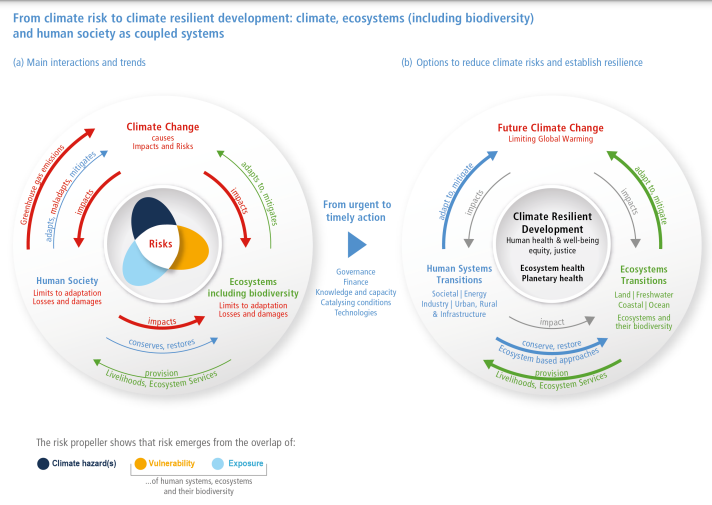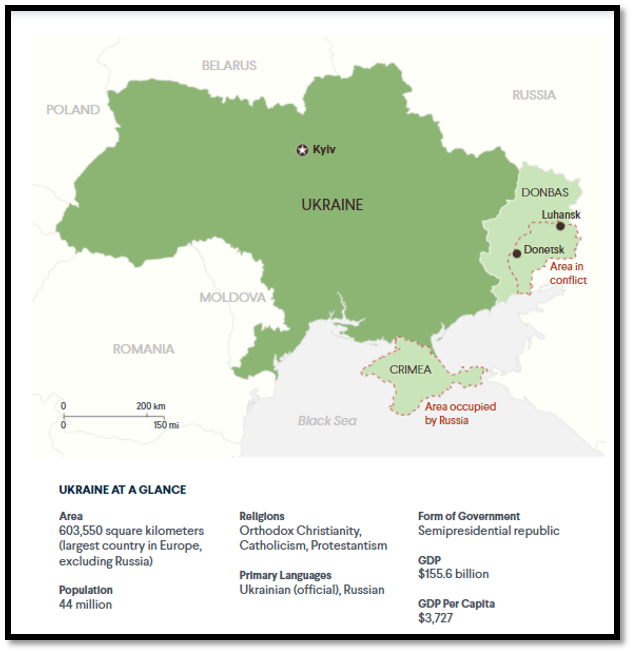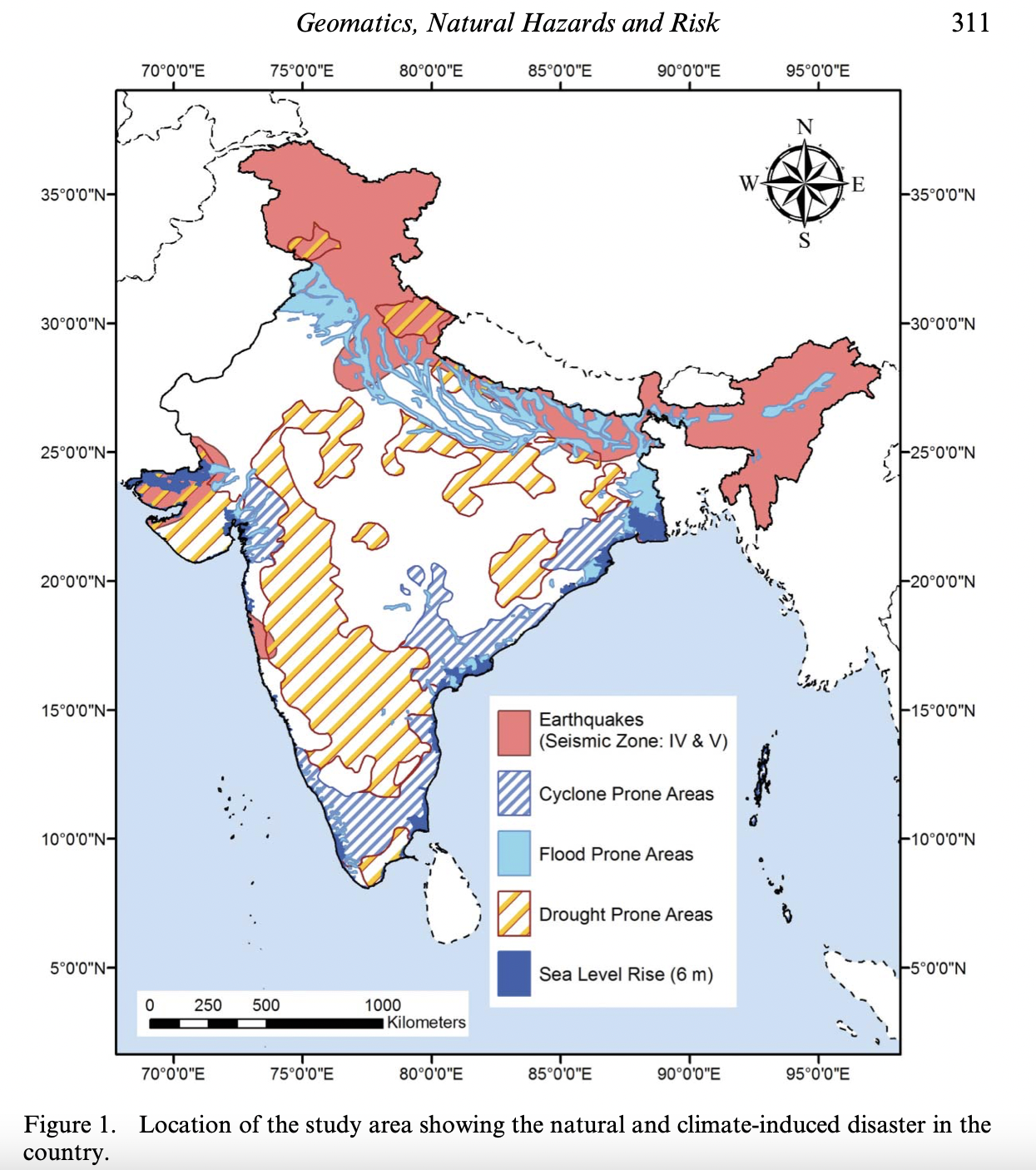26 Mar
The Limits to Growth+50
In News
2022 marks the 50th anniversary of the Club of Rome’s landmark report, ‘The Limits to Growth’.
Introduction
- The Limits to Growth report – published on 2 March 1972 – was the first to model our planet’s interconnected systems. The Report explored the possible impacts of the growing ecological footprint of population growth, human activities and its physical impacts on our finite planet from a systems perspective, as none of these issues can be addressed in isolation.
- The Report’s central point is that “the earth is finite” and the quest for unlimited growth in population, material goods etc would eventually lead to a crash.
Understanding “The Limits to Growth”
“The Limits to Growth” contains six main messages:
- The environmental impact of human society had become heavier between 1900 and 1972 due to both an increase in population and the amount of resources consumed and pollution generated.
- Earth is physically limited, and humanity cannot continue to use more physical resources and generate more emissions than nature is capable of supplying in a sustainable manner. In addition, reliance on technology alone to solve the problem would only delay reaching the carrying capacity of the planet by a few years.
- It is likely, that the human ecological footprint will overshoot the carrying capacity of the planet. This would likely occur due to significant delays in global decision making while growth continued, bringing the human footprint into unsustainable territory.
- Once humanity has entered this unsustainable territory, we will have to move back into sustainable territory, either through “managed decline” of activity, or we will be forced to move back through “collapse” caused by the brutal inherent processes of nature or the market.
- The fifth message is one of hope. “The challenge of overshoot from decision delay is real, but easily solvable if human society decided to act”, meaning that forward looking policy could prevent humanity from overshooting the aforementioned planetary limits.
- The report advocated for an early start to achieve a smooth transition to a sustainable world without needing to pass through the overshoot and contraction phases.

A critical Analysis of Limits to Growth Message
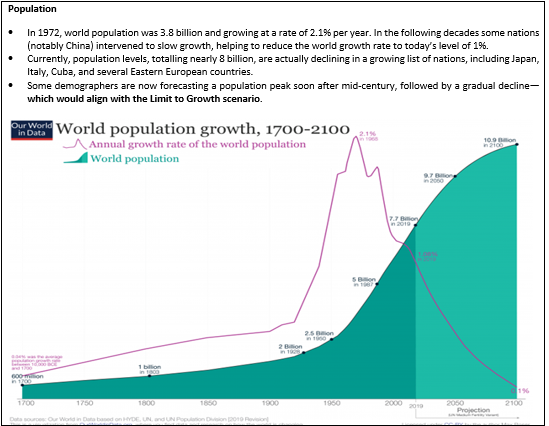
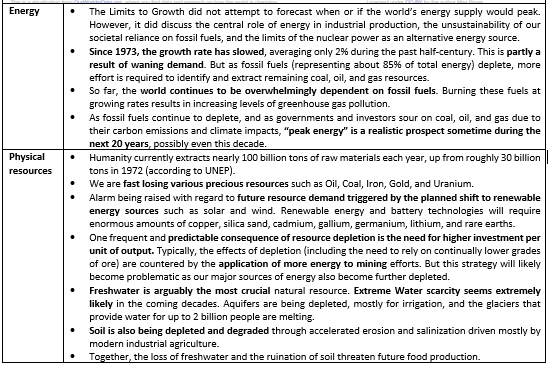
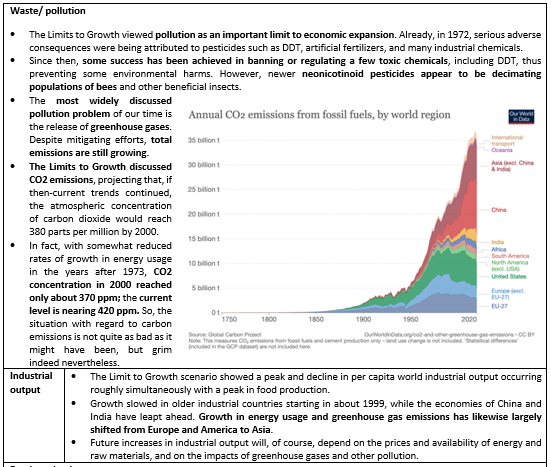
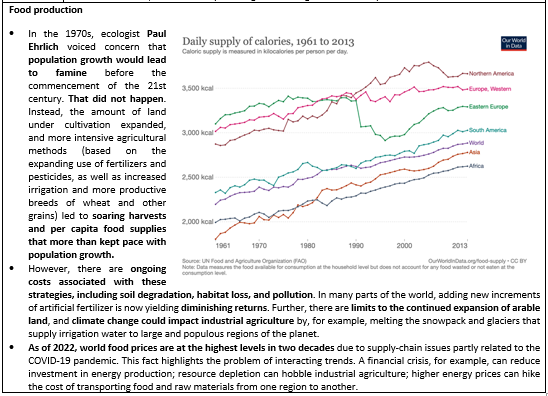
Conclusion of Analysis
- Broadly speaking 50 years down the lane the world has followed the scenario predicted in the book. The human footprint has continued to grow and now exceeds the estimated safe operating space for humanity with respect to the functioning of the Earth’s natural systems, in many areas-most worrying in climate. This is evident in the rise in global temperatures.
- But global society has not yet seen collapse-at least not global collapse. Neither from resource scarcity, emissions of chemicals or toxic substances, land erosion, nor ecosystem depletion.
- There are, of course, growing signs of local collapse-not only driven by global warming, but also by social tensions. In many places there has been a decline in human wellbeing driven by poverty, inequity, disempowerment, and sheer frustration at the slow global response to the global overshoot of nature’s support capacity.
- Although The Limits to Growth mentioned climate change as a likely possibility, it did not attempt to forecast specific impacts. A broad scientific consensus has emerged now that global temperatures are increasing, weather extremes are growing worse, glaciers are disappearing, and sea levels are rising.
- Hundreds of millions of climate refugees are forecast by the end of the century, and food systems could be profoundly impacted. Unfortunately, discussions about threats to our future have tended to become narrowly focused on carbon emissions to the exclusion of any other growth limits.
- There are two drivers of a possible collapse.
- First, non-renewable resources such as fossil fuels should become harder to extract. This makes them more expensive with costs feeding into, among other things, higher food prices and so the global food production system fails to keep up with demand.
- Second, pollution produced by industry swamps the Earth’s capacity to absorb them, with the spillover affecting both food production and human health.
- While The Limits to Growth discussed impacts on nature from increasing levels of pollution, it did not attempt to model the extent of future loss of wild nature. In actuality, this loss constitutes one of the most significant global trends of the past few decades.
- Recent assessments show that, since 1970, roughly two-thirds of wild mammals, birds, amphibians, reptiles, and insects have disappeared. Species are going extinct at roughly 10,000 times the rate that occurred in pre-industrial times.
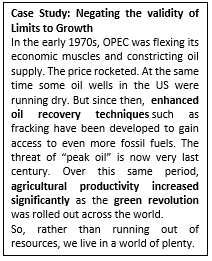
Looking Forward
- Stabilizing populationby setting the birth rate equal to the death rate in 1975, with an average desired family size of two children. The book contained little discussion of population growth reduction methods, aside from full access to contraceptives.
- Implementing radical efficiencyin resource usage, so that resource consumption per unit of industrial output is reduced to one-fourth the 1970 value. This could be achieved by recycling as much material as is physically possible.
- Shifting from encouraging consumption to fostering human development.Instead of maximizing manufacturing and sales of products, focus economic and priorities and policies on education, health care, and cultural activities.
- Reducing pollution per unit of industrial and agricultural output.This requires identifying and adopting less-polluting technologies, methods, and materials.
- Diverting capital to making food affordable for everyone.The authors anticipated that the above conditions would result in changes to the food system that might increase levels of malnourishment, absent policies to make food more affordable.
- Prioritizing sustainable agriculture.Devoting more capital to food production would likely result in more soil erosion and pollution unless steps were taken to reform agricultural practices.
- Increasing the lifetime of industrial capital.This implies better design for durability and repair and less discarding because of obsolescence. This policy also tends to reduce resource depletion and pollution.
Conclusion
Although there’s now a consensus that human activities have irreversible environmental effects, policymakers disagree on the solutions — especially if that involves curbing economic growth. That disagreement is impeding action. It’s time for researchers to end their debate. The world needs them to focus on the greater goals of stopping catastrophic environmental destruction and improving well-being.
Where to use
Geography P1: Economic Geography
Geography P2: Application based question
References
- The Limits to Growth+50
- The Limits to Growth+50: Global equity for a healthy planet
- Limits to Growth +50: Can economies keep growing indefinitely on a finite planet?
- 50 years of the Club of Rome - what have we learned?
- Understanding “The Limits to Growth”: A clear warning and a message of hope
- Living within the limits
- Dennis Meadows on the 50th anniversary of the publication of The Limits to Growth
- The Limits to Growth+50 – Articles and videos:
- Are there limits to economic growth? It’s time to call time on a 50-year argument
- The Limits to Growth:
- Gloomy 1970s predictions about Earth’s fate still hold true:
- Why Limits to Growth's forecasts are still relevant today:
- The Limits to Growth at 50: From Scenarios to Unfolding Reality:
- The Limits to Panic:
- 40 years later, time has not been kind to The Limits to Growth:
- Three Limits to Growth:
- Three Limits to Growth:
- Limits to Growth was right. New research shows we're nearing collapse:
- Limits Revisited—A review of the limits to growth debate. A report to the All-Party Parliamentary Group on LImits to Growth:
- Are there limits to economic growth? It’s time to call time on a 50-year argument:
- The limits to growth: Why the West will struggle to find enough metals to supply simultaneous demand drivers:
India’s Arctic Policy
In News
The Ministry of Earth Sciences released India's Arctic policy titled 'India and the Arctic: building a partnership for sustainable development’.
Introduction
- India’s engagement with the Arctic dates back to a century when ‘Svalbard Treaty’ was signed in February 1920 in Paris.

- Indian researchers are monitoring arctic glaciers for their mass balance and comparing them with glaciers in the Himalayan region.
- India has also been actively involved in studies related to the Arctic oceanography, atmosphere, pollution, and microbiology. Over twenty-five Institutes and Universities are currently involved in Arctic research in India.
- Eight Arctic States—Canada, Kingdom of Denmark, Finland, Iceland, Norway, Russia, Sweden, and USA form the Arctic Council. Since 2013, India has been an Observer nation in the Arctic Council.
- In 2014 and 2016, India's first multi-sensor moored observatory (IndArc) in Kongsfjorden and the northernmost atmospheric laboratory in Gruvebadet, Ny Alesund, were launched in the Arctic region.
- Until 2022, India has successfully conducted thirteen expeditions to the Arctic.
Important Details of India's Arctic policy
India's Arctic policy aims to promote the following agenda—
- Strengthening national capabilities and competencies in science and exploration, climate and environmental protection, maritime and economic cooperation with the Arctic region. Institutional and human resource capacities will be strengthened within Government and academic, research and business institutions.
- Inter-ministerial coordination in pursuit of India's interests in the Arctic.
- Enhancing understanding of the impact of climate change in the Arctic on India's climate, economic, and energy security.
- Contributing better analysis, prediction, and coordinated policymaking on the implications of ice melting in the Arctic on India's economic, military and strategic interests related to global shipping routes, energy security, and exploitation of mineral wealth.
- Studying linkages between polar regions and the Himalayas.
- Deepen cooperation between India and countries of the Arctic region under various Arctic forums, drawing expertise from scientific and traditional knowledge.
- Increase India’s participation in the Arctic Council and improve understanding of the complex governance structures in the Arctic, relevant international laws, and geopolitics of the region.
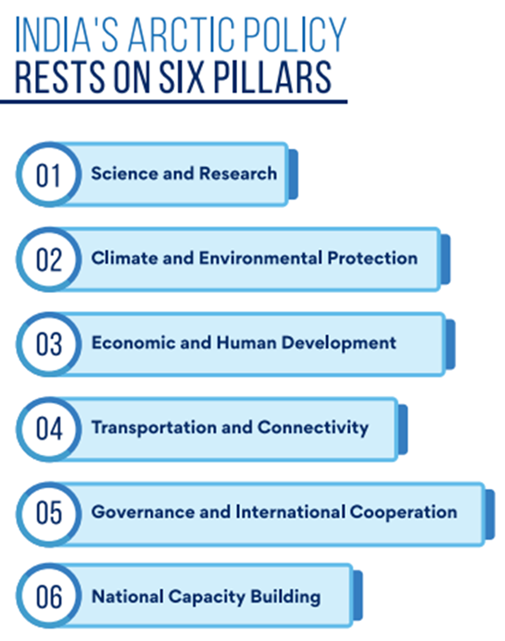
Arctic - Significance for India
- Arctic is commonly understood to refer to the region above the Arctic Circle, north of latitude 66° 34' N, which includes the Arctic Ocean with the North Pole at its centre. The Arctic is home to almost four million inhabitants, of which approximately one-tenth are considered as indigenous people.
- The Arctic influences atmospheric, oceanographic, and biogeochemical cycles of the earth's ecosystem.
- The vulnerability of the Arctic to unprecedented changes in the climate is manifested by the loss of sea ice, ice caps, and warming of the ocean and atmosphere. It will lead to lowering of salinity levels, rising temperature differential between land and oceans in the tropical regions, drying of subtropical areas and increase in precipitation at higher latitudes.
- India is particularly impacted due to the likely effect of these changes on critical aspects of national development such as economic security, water security and sustainability, weather conditions and monsoon patterns, coastal erosion, and glacial melting.
- Indian agriculture is heavily dependent on the monsoons as it receives around 70% of its annual rainfall during this season. The yield of staple summer crops such as rice, pulses and soybeans, which account for almost 50% of India's food output, are dependent upon the precipitation during this period. A good monsoon is critical for India's food security and the wellbeing of its vast rural sector.
- Changes in the Arctic, especially melting Arctic ice, can be highly disruptive for national development, sustainability of over 1,300 island territories and maritime features, and welfare of 1.3 billion Indians.
- The Covid-19 pandemic has exposed the scale of disruption that can be caused by The thawing of permafrost soil as a result of global warming could also potentially release viruses and bacteria that have been dormant for thousands of years, thereby increasing the probability of pandemics.
- There are several synergies between polar studies and the study of the Himalayas. India's vast experience in scientific research in Antarctica and the third pole - the Himalayas, which are endowed with the largest freshwater reserves in the world outside the geographic poles, will help India's scientific community to better understand the Arctic region.
- Melting Arctic ice also opens up new opportunities like energy exploration, mining, food security, and shipping. India can contribute to ensuring that as the Arctic becomes more accessible, the harnessing of its resources is done sustainably and in consonance with international best practices.
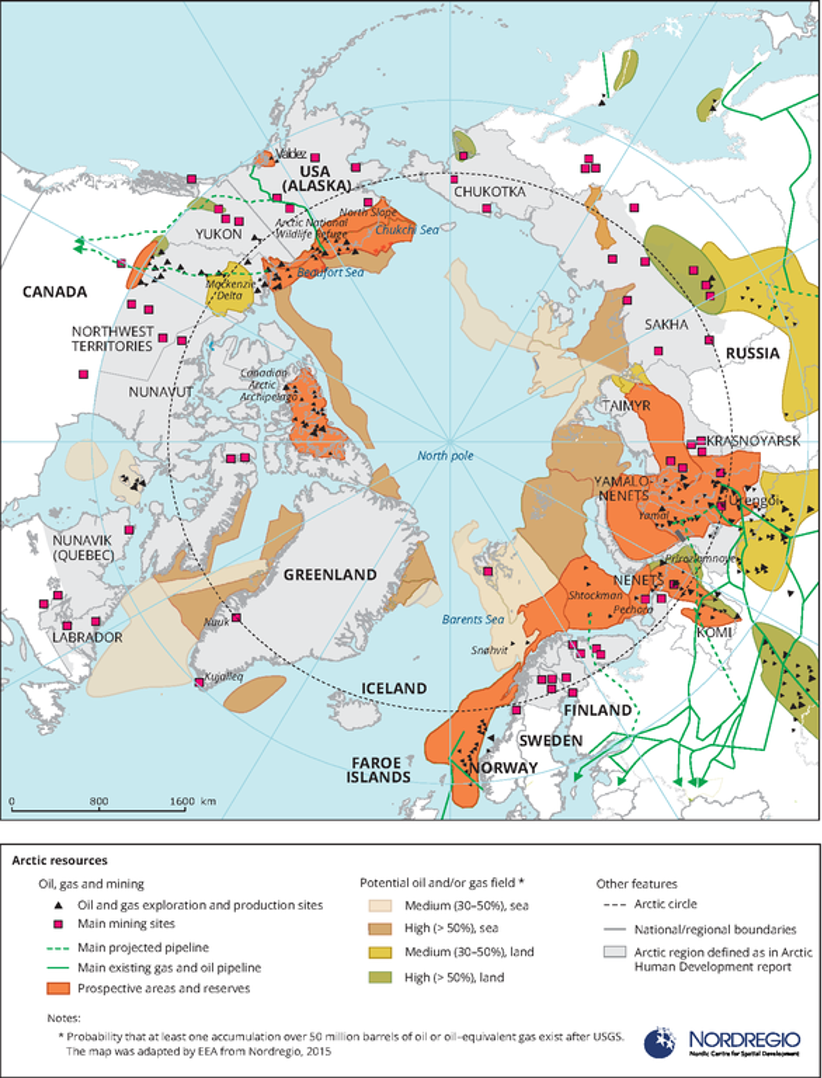
Conclusion: Implementing India's Arctic policy will involve multiple stakeholders, including academia, the research community, business, and industry. It shall define timelines, prioritise activities and allocate requisite resources. The National Centre for Polar and Ocean Research (NCPOR) in Goa, an autonomous institute under the Ministry of Earth Sciences, is the nodal institution for India’s Polar research programme, which includes Arctic studies.
References
- Union Minister Dr. Jitendra Singh releases India’s Arctic Policy in New Delhi today
- India’s Arctic Policy
- India’s new Arctic policy document aim to harmonize polar research with the third pole- the Himalayas
- India unveils its Arctic policy, focuses on combating climate change
- Map- Arctic Resources
- India’s Arctic Policy:
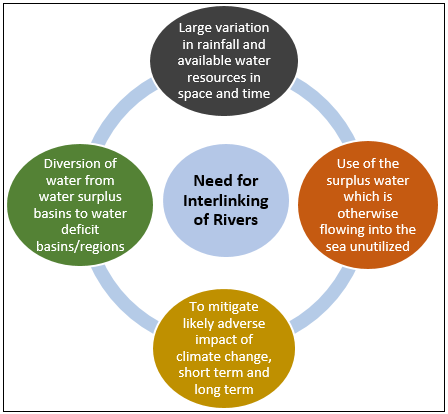
Interlinking of Rivers in India – Issues and Challenges
In News
The government is in the process of creating a new ‘Central Interlinking of River Authority’ for interlinking of rivers.
Background: Interlinking of rivers in the era of climate change
- Climate change events cause erratic spatial and temporal variability in rainfall, temperature, humidity, etc. in long term, and are most severely affecting irrigation, domestic and industrial water supply.
- In a monsoonal climate that is already erratic and highly seasonal in nature, this increased variability due to climate change will further impact water availability and salt water intrusion.
- To overcome such problems, one of the most effective ways is interlinking of rivers i.e., interbasin water transfer from the water surplus rivers to water deficit rivers or regions.
- The National Perspective Plan (NPP) was prepared by the government in August 1980 for water resources development through inter basin transfer of water, for transferring water from water surplus basins to water-deficit basins.
- The implementation of interlinking of rivers as per NPP would give benefits of 25 million ha of irrigation from surface waters, 10 million ha by increased use of ground waters, raising the ultimate irrigation potential from 140 million ha to 175 million ha and generation of 34 million Kilo Watt (KW) of power, apart from the incidental benefits of flood control, drought mitigation, navigation, water supply, fisheries, salinity, and pollution control etc.
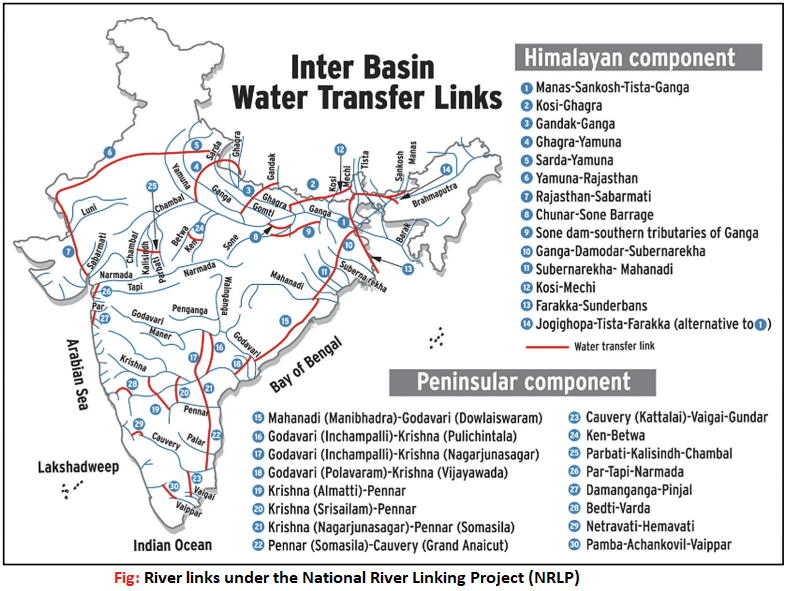

Steps taken so far
- A “Special Committee on Interlinking of Rivers (ILR)” has been constituted in September 2014 for the implementation of ILR programme. A Task Force for Interlinking of Rivers has been constituted by Ministry of Jal Shakti in 2015.
- MoU signed for Ken-Betwa Link Project. It is India’s first river interlinking project.
- The Godavari-Cauvery link project is planned in two phases.
- Phase-I relates to identifying the surplus waters in Godavari basin without affecting the interests of the co-basin States and transferring these waters up to Cauvery through Godavari-Cauvery link project; and
- Phase-II relates to linking Brahmaputra-Ganga-Subernarekha-Mahanadi-Godavari rivers thus enriching the Phase-I with suitable modifications.
- The draft DPR of Godavari-Cauvery link has been prepared considering the Phase-I option only.
Issues and challenges of interlinking of rivers in India:
- Ecological implications:
- Deforestation: River interlinking will require clearance of large area of land which will result in deforestation.
- Biodiversity loss: ILR (Inter Linking of Rivers) would lead to both floral as well as faunal biodiversity loss.
- Impact on aquatic ecosystems: River linking will have negative impacts on aquatic ecosystems, such as water quality changes, loss of habitat, alteration in spawning and breeding grounds, effect on fish migration, changes in land-ocean interactions, effect on fish ecology and biodiversity, impact of inland navigation and/or effect on fish production.
- Habitat fragmentation, loss, and submergence: g., the Ken-Betwa inter-linking project would submerge a major portion of the core area of the Panna Tiger Reserve in Madhya Pradesh. The project will also lead to the loss of two million trees.
- Geo- Hydrological implications: Interlinking of rivers will change geo-hydrological characteristics of river regime.
- Impact on channel morphology: Hydraulic geometry of channel (channel width, depth, stream velocity and sediment load) would get altered as inter-liking will significantly alter the watershed conditions.
- Impact river flow regime: Altering stream discharge will adversely affect the minimum ecological flow of rivers, essential for supporting life in and around channel.
- Adverse impact on Natural River processes like erosion (abrasion, hydraulic action, attrition etc.), transportation and deposition.
- Socio-economic challenges: Large scale displacement of local, especially tribals, without adequate rehabilitation mechanism, would lead to socio-economic crises in form of loss of livelihood, lack of health facilities, spread of disease, food crises, hunger deaths etc. This would adversely affect social well-being of indigenous local communities.
- International implications: Some of the ILR schemes have international implications, with a possible impact on countries like Bhutan, Nepal, and Bangladesh. It had caused much anger and dispute in Bangladesh which fears that diverting of water would result in long dry-spells for them since Both Ganga and Brahmaputra Rivers provide 85% of the Bangladesh’s fresh water flow in the dry season.
Way forward: The interlinking of rivers project is a major challenge and an opportunity to deal with the water related problems springing up drought, floods, climate change and so on. The long term strategy to water deficit problem lies in making the interlinking of rivers challenges by building a network of dams, reservoir, barrage, hydropower structures and canals throughout the geographical regions of the country. However, Interlinking of rivers is definitely a good solution for the shortage of water, but interlinking has to take place after a reconnaissance survey and detailed study so that does not cause any trouble to the environment or aquatic life.
Where it can be used?
It can be used in topics related to Paper 1 (Environmental degradation, Biodiversity and sustainable development and climate change), Paper 2 (Floods and droughts, Water resources, Sustainable development) and GS 3 (Environmental degradation).
Sources:
2) Interlinking of Indian Rivers: Issues and Challenges
3) Interlinking of Rivers in India: Advantages and Challenges
Thermokarst
- It is the depression landform formed in the (Region of permafrost) Arctic region or some time in Himalaya and Swiss Alps.
- Its formation is related to the thawing of ground ice. It can form due to collapse of Pingo, Ground-ice mud slumps.
- It is characterised by very irregular surfaces of marshy hollows and small hummocks formed as ice-rich permafrost thaws.
- Some thermokarst features result from climatic change, but most relate to minor environmental changes that promote thawing; for example, the shift of a stream channel, natural and human-induced disturbance to tundra vegetation.
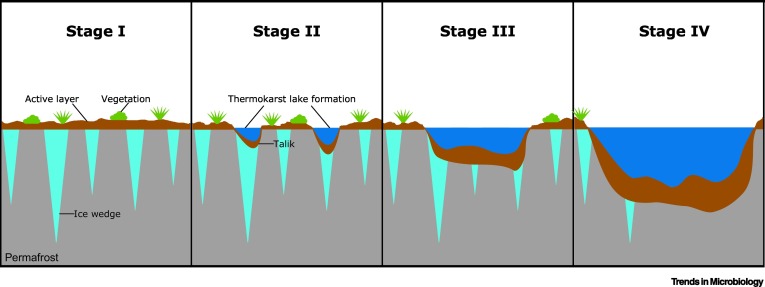
Source
Image source:
Potential evapotranspiration
- It is the total amount of water that will potentially get evaporated in a particular environment if sufficient water is supplied.
- It is the index of thermal efficiency of water loss.
- It represents the total amount of moisture and heat transferred to the atmosphere from both soil and vegetation. Thus, it also represents the total amount of solar energy received.
- It is calculated from the mean monthly temperature of a month adjusted for the day’s length.
- Thornthwaite used the concept for calculating thermal efficiency Index to classify different types of climates.
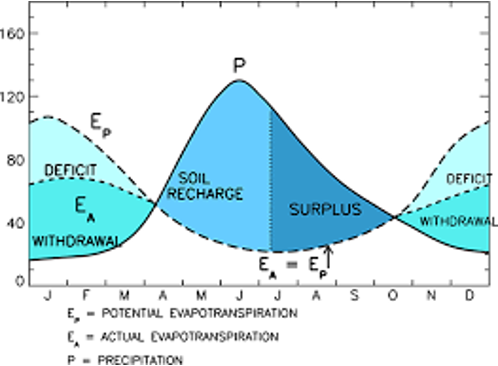
Source
Permafrost - Edukemy Current Affairs
- It is the thermal condition in the soil where the temperature remains below the freezing point for at least 2 consecutive years.
- The term was first introduced by S.W.Muller in 1947, as a shortened form of permanently frozen ground.
- The permafrost does not indicate the frozen ground.
- Water may not be always frozen in permafrost because of dipping in the freezing point below Zero, on the account of soluble minerals in the groundwater.
- The upper boundary of permafrost is known as the permafrost table, and the near-surface layer, which is subject to seasonal thaw, is called the active layer. The depth at which annual temperature fluctuations are minimized is termed the depth of zero annual amplitude.
- Distribution - Permafrost forms approximately 20–25% of the Earth’s land surface. It is widespread in Siberia, northern Canada, Alaska and China.
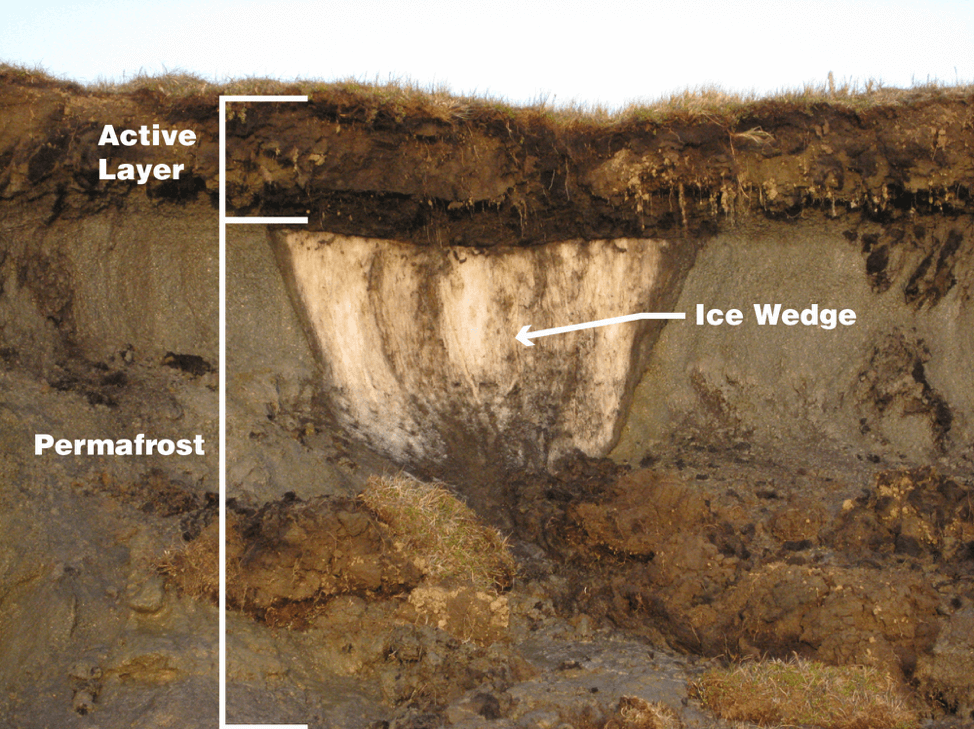
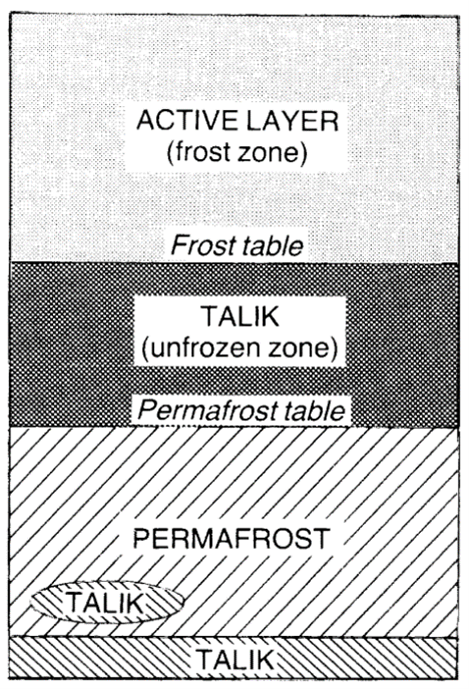
Source:
Image source
Reclaiming the badland of loess plateau China

Background
- Location: The Loess Plateau is located in northwestern China, near the upper and middle reaches of the Yellow River.
- Size: It is the world's largest area of loess, covering more than 600000 km2 and accounting for 6.6% of China's total land area.
- Geology: Almost the whole loess region is covered with a thick layer of fine but loose soil because of its thick but loose and fine soil which makes it very important for agriculture.
- Climate: A semi-arid arid climate with ~45cm of annual precipitation makes it a very fragile ecosystem. The region has the most highly erodible soil on earth, susceptible to the forces of wind and water.
- Problem: The region has about 270000 gullies (each longer than 500 m), which hampered its socio-economic growth.
What was done for Reclamation of the badland of loess plateau?
- In 1999, the Chinese government started implementing the Grain for Green (GFG) Project to convert farmland to forests, shrubland and grassland, aiming to counteract soil erosion.
- To improve the carrying capacity of the region and support the growing urban population Gully Land Consolidation Project was launched
- The Grain for Green Project and the Gully Land Consolidation Project have been combined to reshape the Loess Plateau's ecosystem and topography, as well as the livelihoods of its population, in recent decades.
How did the initiatives benefit the area?
- The surface runoff got reduced by 0.46mm/year. Land-use change was estimated to have a 63.52% impact on streamflow reduction.
- the forest and grass coverage increased by 11.5% from 2000 to 2008.
- The silt load in the Yellow river dropped to 1/5th.
- These two projects have achieved a balance between green protection, new land creation, and improved food security and livelihood of local people in the hilly areas of China.
Source:
Places in news
|
Corbett Tiger Reserve
|
|
Sabarmati River
|
|
Tikamgarh
|
|
Mekedatu Dam
|
|
Zojila Pass
|
|
Karnal
|
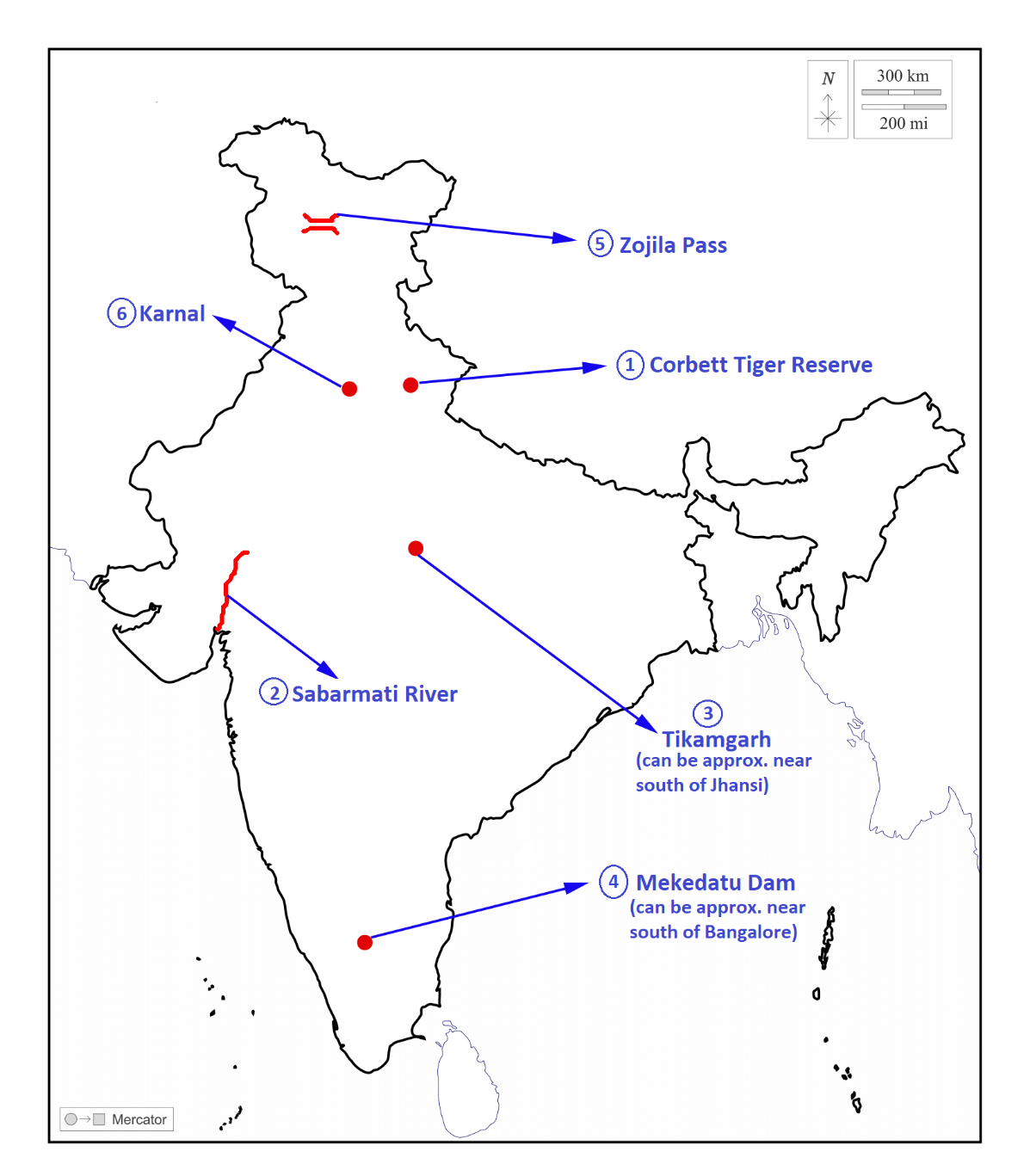
Share the article
Get Latest Updates on Offers, Event dates, and free Mentorship sessions.

Get in touch with our Expert Academic Counsellors 👋
FAQs
Geography Current Affairs focuses on the contemporary issues, events, and developments in the field of geography. It covers recent geographical phenomena, environmental changes, geopolitical shifts, and related news. This differs from regular geography studies which may focus more on foundational concepts, historical contexts, and theoretical frameworks.
Updates are provided regularly to ensure that subscribers stay informed about the latest developments in geography. Typically, updates are provided on a fortnightly basis, depending on the frequency of significant events and changes in the field.
Absolutely. Geography Current Affairs serves as a valuable resource not only for Geography optional but also for GS papers, especially GS Paper 1 (covering Indian Heritage and Culture, History, and Geography of the World and Society) and GS Paper 3 (covering Technology, Economic Development, Biodiversity, Environment, Security, and Disaster Management). It aids in building a holistic understanding of various topics and strengthens answer-writing skills by incorporating contemporary examples and perspectives.
Geography Current Affairs holds immense importance for UPSC preparation, particularly for aspirants opting for Geography optional. It helps candidates stay updated with the latest developments, geographical phenomena, environmental issues, and geopolitical shifts worldwide, aligning them with the dynamic nature of the subject as tested in the UPSC examinations.


